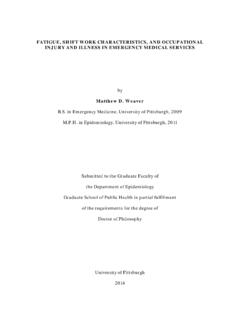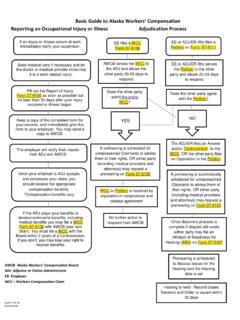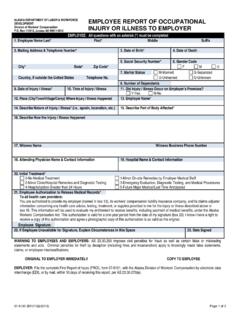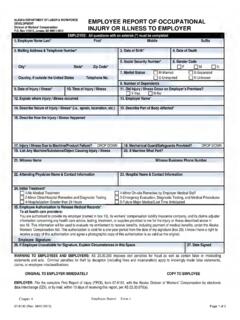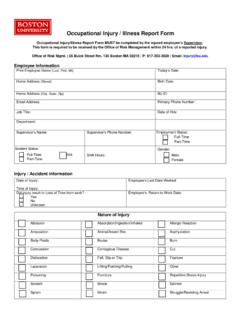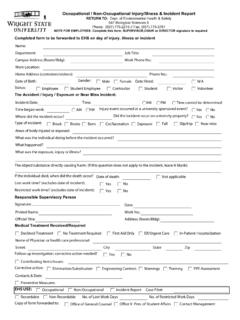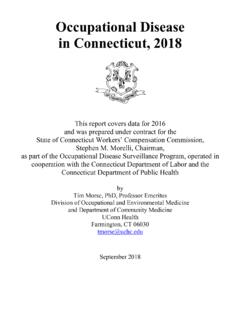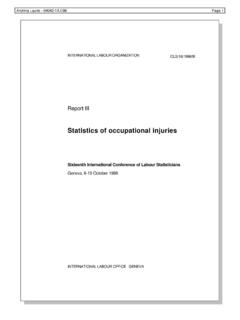Transcription of OCCUPATIONAL ILLNESS IN OECD COUNTRIES
1 Chapter 4 OCCUPATIONAL ILLNESS IN OECD COUNTRIES A. INTRODUCTION In addition to the sometimes considerable risk of suffering from an OCCUPATIONAL injury , health hazards accompany many work processes. Typical health hazards include toxic and carcinogenic chemicals, gases and dusts, ergonomic factors such as strenuous working postures, and physical factors such as noise, vibration and extreme temperatures. The results of the exposure to these hazards can be acute or chronic OCCUPATIONAL ILLNESS such as respiratory and lung disease, skin conditions, systemic poisoning, OCCUPATIONAL cancer, hearing impairment or neurological disorders. This chapter focuses on the spread and evolution of OCCUPATIONAL diseases in OECD COUNTRIES . It follows on Chapter 4 of the 1989 Employment Outlook, which presented an analysis of OCCUPATIONAL accidents, and represents the second of a two-part series on OCCUPATIONAL safety and health.
2 The analysis in 1989 already pointed to the linkage between labour market conditions and workplace hazards. Some further evidence of this linkage, which has recently become evident, is set out separately (see the accompanying Further Note on OCCUPATIONAL Accidents ). In Section B, the chapter first considers the availability of and limits to comparative data on OCCUPATIONAL ILLNESS . This is followed, in Section C, by a discussion of the incidence of fatal and non-fatal OCCUPATIONAL diseases as they have evolved since the 1960s, their distribution by industry and their changing composition by ILLNESS category. Section D brings together major findings and derives some conclusions. B. PROBLEMS OF DEFINITION AND COMPARISON The term OCCUPATIONAL disease is linked to the identification of a specific cause-effect relationship between a harmful agent and the affected human organism.
3 However, it is not easy - and considerably more difficult than in the case of accidents - to prove that a disease is occupationally conditioned, caused by conditions at, not outside, work. Due to their different fact-finding and regulatory mechanisms, Member COUNTRIES define a varying number of diseases as occupationally conditioned. In fact, a country s list of recognised OCCUPATIONAL diseases itself reflects a value judgement as to those illnesses for which the workplace is to be held responsible and which are considered eligible for special compensation. As a rule, the more concretely the cause-effect relationship can be established, the more likely it is that a condition will be recognised as an OCCUPATIONAL disease. However, the causal chain between OCCUPATIONAL activity, exposure to a hazard, and onset of ILLNESS may be elusive for a number of reasons [Hilaski (1981); ILO (1987); WHO (1985)l.]
4 First, many OCCUPATIONAL diseases are clinically indistinguishable from general chronic diseases resulting from other factors. Workers spend about three-quarters of their productive lives outside the working environment; ILLNESS may therefore be the result of harmful exposure both on and off the job, and it is often not possible to assign weights to these factors respective influence. On the other hand, a worker may be exposed to two or more hazardous agents on the job, in which case the cause-effect relationship can be confused. Furthermore, the sometimes long latency periods of individual diseases impede their timely recognition1 . In addition, the lack of medical expertise, insufficient training in OCCUPATIONAL medicine, is often an obstacle to the correct classification of a disease as OCCUPATIONAL . If there is no effective health supervision of workers, including systematic periodical examinations by competent company or other doctors, many OCCUPATIONAL diseases will escape detection.
5 Finally, the hundreds of chemical substances newly available each year, often without having previously been tested for health effects, make diagnosis difficult. When testing of substances does occur, results are primarily based on animal tests, and are therefore not easily extrapolated to the human organism. 105 Besides these conceptual and diagnostic difficulties, different reporting and data-gathering procedures and varying degrees of population coverage further distort international comparisons - as has indeed been shown for OCCUPATIONAL accidents in the 1989 Employment Outlook. It will be recalled that statistical coverage of civilian employment varies largely from country to country, as do the classification and coverage of particular industries. In some COUNTRIES , data on OCCUPATIONAL diseases are collected and published via insurance agencies, in others via labour inspectorates, in yet others via statistical offices by means of labour force or establishment surveys.
6 The person required to report the disease may be the victim, the employer, an industrial medical officer or company doctor, a private doctor, or some combination of all of the above. In addition, time limits for reporting diseases differ considerably. Overall, then, international data comparability on OCCUPATIONAL diseases is rather poor. This is true even by comparison with the field of OCCUPATIONAL accidents. Compared with workplace accidents, incidence rates of OCCUPATIONAL diseases are difficult to establish with any certainty since health hazards can manifest themselves in ILLNESS while the worker is no longer at his job. This difficulty applies, in particular, to industrial breakdowns since a disease may be due to exposure during employment in a particular industry division which the worker has long since left.
7 Rates may also be distorted due to drawn-out examinations of reported diseases by medical boards and the subsequent delay of decisions from one calendar year to the next2. Because of the difficulty in proving a disease to be OCCUPATIONAL in origin, most COUNTRIES have produced lists of prescribed OCCUPATIONAL diseases. These are generally limited to those diseases where a strong cause- effect relationship has been proven. However, with the number of categories ranging from 50 to 90, national lists vary in terms of those diseases recognised as OCCUPATIONAL . Recommended lists developed by the International Labour Office and the European Communities seem to have led only to a limited degree of harmonization3. National lists are also constantly changing due to medical discoveries and changing attitudes to health. For example, a number of COUNTRIES that once recognised only clear cases of total deafness due to OCCUPATIONAL exposure for compensation purposes are now prepared to compensate workers for differing degrees of hearing impairment.
8 In some COUNTRIES , in addition to the prescribed list, other diseases which are strongly suspected to be work- related may also be recognised and compensated. In another group of COUNTRIES where no prescribed list has been developed, in principle every disease can be recognised and compensated as occupationally conditioned; however, in these COUNTRIES , the burden of proof tends to fall wholly on the claimant and there is a lower level of assurance that his claim will eventually be recognised [Greiner (1986)]. C. THE EVOLUTION OF OCCUPATIONAL DISEASES While, as one study observed, it is unlikely that the true extent of work-related ILLNESS can ever be accurately assessed [European Foundation (1988)], this section presents data on the evolution of OCCUPATIONAL diseases in OECD Member COUNTRIES as published by national authorities, with data on fatalities due to OCCUPATIONAL ILLNESS taken up first.
9 It should be kept in mind that the discussion which follows of diseases registered with medical boards or other bodies covers only a portion of the phenomenon of ill health in working life. Regular sickness absenteeism, for example, is much more widespread than absences from work of employees with recognised OCCUPATIONAL diseases. Other data sources could throw additional light on the relationship between work and health: for example, survey-based information on workers perception of physical and organisational stressors such as overload, uncomfortable working postures, mental strain or monotony. However, these issues cannot be considered here [see OECD (1986c, Chapter 111); Nordic Council (1984, Chapter 5)]. 1. OCCUPATIONAL fatalities due to ILLNESS a) The evolution of OCCUPATIONAL fatality rates A number of studies have reported that the incidence of deaths from OCCUPATIONAL diseases is several times higher than that due to accidents [Ashford (1976); Berman (1978); Barth and Hunt (1980)].
10 However, this claim has been contested and is, in any event, hard to verify due to the difficulties discussed above in diagnosing OCCUPATIONAL ILLNESS , and the elusive cause- effect relationship between specific working conditions and resulting deaths. One of the major causes of differences in mortality statistics is the varying definitions used by Member COUNTRIES for a disease-related OCCUPATIONAL fatality. Some COUNTRIES count only those deaths that occur relatively quickly after detection of a specific ILLNESS - for example, before the end of the year in which the disease was reported, or (as in France and Germany) before a decision on the award of a pension could be made. Others include all deaths of persons for which an 106 OCCUPATIONAL disease has been determined as being the primary causal factor.










